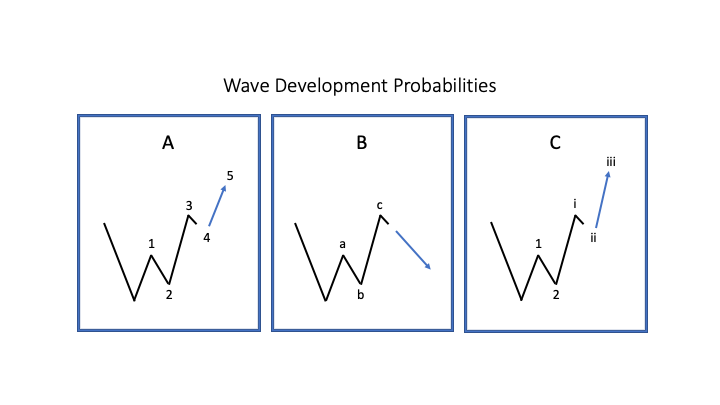
Supplement: Wave Development Probabilities
My blogs on 15 and 21 November presented two different wave counts, one showing upward potential and the other a downward potential. I did warn in my 15 November blog that the situation was uncertain with the STI possibly going up, sideways or downwards. This has prompted me to write this supplement, as some readers might think that the Elliott Wave Principle (EWP) is just a guessing game.
The EWP method of counting waves is based on a small set of impulse and corrective wave patterns, with some variations, which must follow set rules and usually following some guidelines. Counting the waves in real time can be challenging as the waves can morph from one pattern to another, all the while keeping to the rules and guidelines.
The above diagrams illustrate how this can happen, They all have the same structure, which was the case shown in my 15 Nov blog. My first prognosis was as shown in Diagram A, with the structure developing as an impulse wave with five subwaves. Waves 1, 2 and 3 have 5, 3 and 5 subwaves respectively. At this juncture there are two other possibilities that can develop, as shown in Diagrams B and C.
In Diagram A, Wave 4 can go down further instead of turning upwards to form Wave 5. This indeed happened as shown in my 21 Nov blog. The wave structure has morphed from an impulse wave into a corrective Wave abc as shown in Diagram B. Diagram A is no longer valid as Wave 4 has entered into the territory of Wave 1, breaking an EWP rule. Note that the 5-3-5 structure has not changed, as Wave abc is a zigzag with a 5-3-5 structure. Wave abc could be part of a larger zigzag (going downwards), or a triangle (going sideways), or a combination corrective wave.
This is not the end of the story. Diagram C shows a third possibility. The current wave development could be an extended Wave 3, with five relatively large subwaves consisting of Subwave i, ii and potentially iii, iv and v. The completion of Wave 3 will be followed by Waves 4 and 5 to complete the whole impulse wave. The important point here is that if Subwave ii dips below the top of Wave 1, it does not break a EWP rule as this is Subwave ii and not Wave 4. But an EWP rule will be broken if Subwave ii falls below the start of Subwave i.
Thus you can appreciate that the skill in counting waves correctly requires good pattern recognition and being mindful of the EWP rules and guidelines. On a real time basis, a count has to be adjusted if it becomes invalid. Eventually a proper and valid wave count will emerge.
